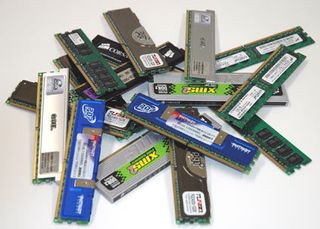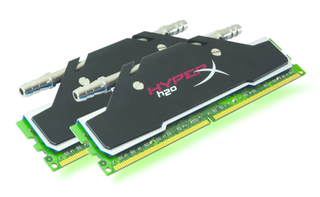How to Overclock RAM
Warranty, RAM Cooling And Final Note
Vendors, Damage And Warranty
We’ve discussed damage to ICs and electromigration in the context of overclocking before, and we’ve mentioned vendor-advertised default values for RAM performance.
There are many RAM vendors, but not all manufacture the ICs they use to build modules, and there are only a handful of memory manufacturers, including Samsung and SK hynix. The kit vendors purchase memory ICs and solder them onto PCBs. Different vendors may list different values for voltages and timing latencies using the same chips.
Vendors test each chip in order to program the EEPROM on-board the module with voltage and timing latencies; it is the integrated memory controller and parameters set via the motherboard firmware that control the memory’s final voltage and timing in the system, so once power has been turned off, there is no way to check what parameters or voltage were applied to the memory, short of actual physical damage.

Often, the pre-programmed memory frequency and latency values on the DRAM’s EEPROM are lower than the actual advertised value; the memory will boot with conservative settings for compatibility with a wide variety of systems. From there, voltages, latencies and clock rates must be set via the motherboard firmware. This is by design from the vendor’s point of view, and will not violate the warranty.
Straying above the datasheet voltage value (1.5 or 1.65 or even 1.8 volts) or loosening the RAM timings leaves no trace on the chips themselves. In fact, the bottleneck for memory voltage is the IMC (e.g. 1.55 volts for Intel’s Sandy Bridge CPUs).
Keeping the above factors in mind, there are two major sets of values you should check before overclocking the memory chip:
- The maximum memory speed, clock rate, and voltage allowed by the CPU and/or the IMC. These values can be exceeded, but that really depends upon the silicon lottery, and there is a higher chance of causing physical damage.
- The maximum voltage and speed for the specific memory module (not the vendor’s advertised values). This requires a glance at the original memory module manufacturer’s datasheet.
RAM Cooling
There is some disagreement in the overclocking community about how much RAM benefits from active cooling. RAM doesn’t really perform too much better at cooler temperatures, but serious overclocking still heats up the memory chips. On the whole, unless a system is intended for extreme benchmarking or testing, passively cooling the memory chips is sufficient, though having an additional fan blowing air over the area certainly won’t hurt.

If you are already using a CPU liquid-cooled loop, putting in a water block for the RAM is relatively easy if that's the route you want to go. Alternatively, vendors have water cooling-ready memory packages, like the Kingston HyperX H2O series.

This brings us to heat spreaders and vendor-supplied heat sinks. It used to be that spreaders were almost purely aesthetic. There are also reports that certain vendors have, in the past, glued heat spreaders on to disguise the quality of the memory modules or ICs. But current-generation heat spreaders from reputable vendors do make a difference in operating temperatures, and when the same kit is provided in two different packages—one with a heat spreader and one without—going for the heat spreader makes technical sense.
A Final Note: “Overclocking” Memory vs. Regular Memory
Apart from the aesthetics and marketing, there is no specification difference between “overclocking” or “pro” or “gaming” memory and regular memory if the same IC is used. However, given the chip-to-chip variability of memory modules, vendors will often test and pre-select higher-performing modules/chips, label them as “overclocking” memory, perhaps add a heat spreader and, most important, set the pre-configured timings in the EEPROM to values optimal for overclocking, given a certain training regimen. This only applies to reputable vendors, though—any memory can be overclocked, and marketed as such.
MORE: Best Memory
MORE: DDR DRAM FAQs And Troubleshooting Guide
MORE: The Most Common DDR DRAM Myths Debunked
MORE: Navigating the Memory Upgrade Jungle
MORE: All Memory Content
Stay on the Cutting Edge
Join the experts who read Tom's Hardware for the inside track on enthusiast PC tech news — and have for over 25 years. We'll send breaking news and in-depth reviews of CPUs, GPUs, AI, maker hardware and more straight to your inbox.
-
Sakkura Perfect timing, I was just about to get to work on my DDR3-1600 kit. Gotta squeeze out all the performance possible from my aging Ivy Bridge build. Especially now that I'm running VR.Reply -
BobsKnob You know why there's no benchmarks? Because overclocking memory offers such small 'real world' gains that it's not even worth it. You might as well try to overclock your usb ports. This is just a lame attempt to advertise products, in this case Kingston and Arctic heat spreaders and try to pass it off as reporting.Reply -
derekullo They also mentioned Mushkin, Crucial and G.Skill.Reply
Heaven forbid they mention the manufacturer of the ram in an article about overclocking ram.
Now if this would have been an article about Farcry 5 or Elder Scrolls 6 and they had a picture of an Arctic Heat Spreader then you would have been on to something. -
BobsKnob Thank you for proving my point. It's just advertising masquerading as reporting.Reply
You know, there used to be a time when Tom's did real, unbiased reviews and reporting. When something sucked...it sucked and the review wasn't candy coated. -
dish_moose I'm with Bob on this one - until you show real wold benchmarks showing real improvement from OC RAM, I won't waste my time.Reply
-Bruce -
Maxxtraxx Check out the youtube channel Digital Foundry, this video specifically: https://www.youtube.com/watch?v=Er_Fuz54U0YReply -
Maxxtraxx Proof of increased performance from Ram Overclocking from real world benchmarks can be found here:Reply
https://www.youtube.com/watch?v=Er_Fuz54U0Y
Am I not allowed to edit my own posts? or am i really missing something here? I wanted to say more after I posted but could not find any way to edit my own post.
